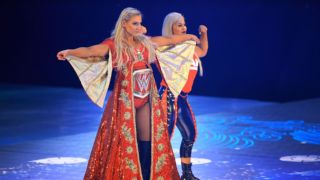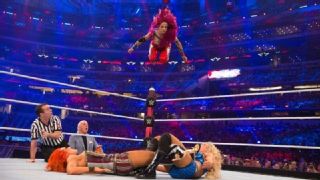|
Outside of it marking a dramatic shift in how the WWE was handling its women's division, few knew what to expect after Charlotte Flair, Sasha Banks and Becky Lynch debuted on the July 13, 2015, edition on Monday Night Raw. The trio, alongside fellow Four Horsewoman Bayley as well as Paige and Emma, had completely changed the landscape of women's wrestling during their time in NXT with intensely physical matches and a connection to the crowd unlike most who had come before them. Over the course of the next 28 months, key milestones fell at a staggering pace. The Divas championship was replaced by a women's championship at WrestleMania 32, and the ensuing match can be put up against anything else that happened that night as one the most impressive showings on the card. There was ultimately a brand split, with enough women on each roster to establish two independent divisions and a champion for each brand. There were main events on Raw and SmackDown, first-time stipulation matches pushed women to even greater heights and, ultimately Flair and Banks pushed their bitter rivalry to its brink inside Hell of a Cell in the first ever women's match to main event a pay-per-view. But in between all of these big "firsts" and monumental matches, there's everything in between. As we head into Survivor Series, with women's matches making up 25 percent of the card, it's become increasingly clear that these moments don't come easy, and each woman on the roster has had to earn their way up to the top. After a lot of big splashes over the last couple of years, the 'Women's Evolution' continues to grow and change through the daily efforts of everyone involved. Though their goals have become grander through everything that's been achieved to this point, they're still fighting the battles that every generation of female superstars has strived for in this business -- seeking out and maximizing on every opportunity possible, and as an effect, making things easier for everyone who will follow in their footsteps. For this generation's stars that are finally getting to enjoy some of the fruits of their labor, it was not an easy path. Whether it was kicking things off on the independent wrestling circuit, like Banks, Bayley and Lynch did, or making the transition from a drastically different world, the struggle to even start down the road to greatness was fraught with perils, both internal and external. But fighting through the pressures and the doubt helped forge a generation of competitors that continues to change the landscape. "Well, because I didn't grow up wanting to be a WWE Superstar, I questioned it every day for the first year-and-a-half," said Flair, during a recent visit to ESPN headquarters in Bristol. "I had gone through a lot emotionally. I just lost my brother, and what my Dad went through. It was a struggle, but it made me who I am today."  Flair was part of the first generation to train at the WWE's revolutionary Performance Center, and the effect it's had in maximizing the assets available for up-and-coming superstars is still being understood. That goes even more for women with extraordinary potential coming into the Performance Center, who otherwise might not have known a path towards WWE superstardom. And it doesn't end with the physical and in-ring training -- not by a long shot. "It opens the door for more women to come in," Flair said of the Performance Center. "And then, having a female trainer, Sara [Amato], it just makes a difference. Having a woman being able to relate to how we feel every day and then fighting for us makes a difference, too. Fighting for the time, the storylines, and bringing these larger than life characters out of us, too." It's been a collective effort since the Four Horsewomen first started to pick up momentum in NXT, but even as Flair and Banks stole some of the headlines on Raw, Lynch was an anchor for a more balanced talent roster on SmackDown. "Having the first and second women's Money in the Bank ladder matches, that was huge," Lynch said, during a recent interview with ESPN.com. "Being the first women to main event Smackdown was another milestone moment. Cage matches and table matches, and all of these kinds of things. Lynch even managed to pull off something that had become almost completely taboo in the WWE -- and did so in a match that was highly entertaining. "Having the first inter-gender match in maybe nearly a decade with James Ellsworth. We're constantly moving forward and changing the game," said Lynch. "I think people just got so invested in the storyline we were having, especially on social media with him costing me the Money in the Bank briefcase, interfering in my match at WrestleMania and costing me matches countless [times] on TV. "I think it was done in an entertaining way that it was easy to watch," said Lynch. "You know, that there wasn't any offense brought, which was great. And then I think it opens the doors to other opportunities for that to happen again." Over the last few years, the efforts within the women's divisions have made an impact in a number of other ways as well. One of the most rewarding elements for both Flair and Lynch has been to see the reactions from fans who are now connecting to the product in a much deeper way.  "Hearing women come up and say that we're the reason that they're watching now," Lynch said, "Because they maybe didn't have anybody that they related to before, and now they do." The positive momentum has also made an almost immediate impact on the current content that WWE is producing. The concept of a 32-woman tournament featuring a mix of contracted and non-contracted talent under a WWE banner would've been almost unthinkable five years ago, if only because the talent pool to draw from was unrecognized, too spread out or too unknown. Between that spotlight, and several waves of women signed by WWE over the last two years, the ecosystem continues to change as the full effects of this movement are recognized. "Seeing so many women in the Mae Young Classic that I was on the independent circuit with, we're talking 12 years ago, there wasn't necessarily going to be a light at the end of tunnel for them," said Lynch. "But they kept working passionately because they love this business, and to see them get the opportunity to shine, I think that was phenomenal." "It was great feeling like I had a hand in helping that in any way, shape, or form," Lynch continued. "Because so many people, they really just love what we're doing. They love seeing that the possibilities now for women are endless, because there really, really are." The momentum has reached its peak, but as much as this generation of women has been able to accomplish, those that came before them played an integral part in laying the foundation and passing on knowledge and experience at key moments in their careers. "When I won the NXT women's title from Natalya at Full Sail, becoming the second-ever woman's champion for NXT, that's when I knew, 'Okay, I'm doing the right thing' and that I could do this," said Flair. "She instilled a confidence in me that night." You can trace it back to Nikki Bella and AJ Lee, who each had long reigns as champion, and Natalya and Beth Phoenix, who did tremendous work together and against one another in an era where there weren't a lot of intensely physical matches for women. It goes back to Lita and Trish Stratus and their legendary rivalry; Alundra Blayze and Bull Nakano in the 90s; and Wendi Richter and Leilani Kai, who faced off in one of the most high-profile matches at the first WrestleMania. In the WWE alone, there were numerous others who played major parts in laying the groundwork over the last 30 years.  It's simply not something that can happen overnight. On the current trajectory of WWE, it's not crazy to expect that over the next decade, the proportion of men to women on the Raw and SmackDown rosters will start to balance out and the thought of three women's matches on a single episode of TV or a pay-per-view won't be such a momentous occasion. But becoming a WWE superstar is a process that simply can't be rushed. "Would it be ideal to have more numbers? Absolutely. But it's just, it takes years," said Flair. "I've been on the main roster for two and a half years. You know, I feel like now the main roster finally knows who Charlotte is. But it took two and a half years. "I think what people don't realize is the transition from NXT to the main roster is a big jump," said Flair. "It's getting a whole new audience familiar with a certain character. If you debut too many women at one time, it's hard for the audience to get to know, understand, and see the rise of that character." If there's one major milestone that still seems to hang over the women's division, it's the main event of WrestleMania. Lynch and Flair have both expressed that desire on many occasions, and after 33 years (and counting) of the company's biggest showcase without such a match, it seems like just a matter of time until the right circumstances fall into place. The dramatic changes we've already seen also allow the superstars of today hopes and dreams of an entirely different scale of success. "I want to be a larger-than-life superstar who is known worldwide, outside of the WWE," said Flair, "Becoming an attraction for the company. If you look at the Rock's crossover, Stone Cold, my Dad too, in his era, I want to do that. I want to mean that much to the industry. That's just a matter of working harder every single day." By the time all is said and done in the careers of this transformative generation, their successes will only help those who've yet to realize their dreams. A rising tide lifts all boats, and there's still plenty of room to grow. "I've had these great moments, but it's still not enough," said Flair. "I want the women to have this division where you're turning on WWE because you're there for the women, not the men -- that's my goal."
|

